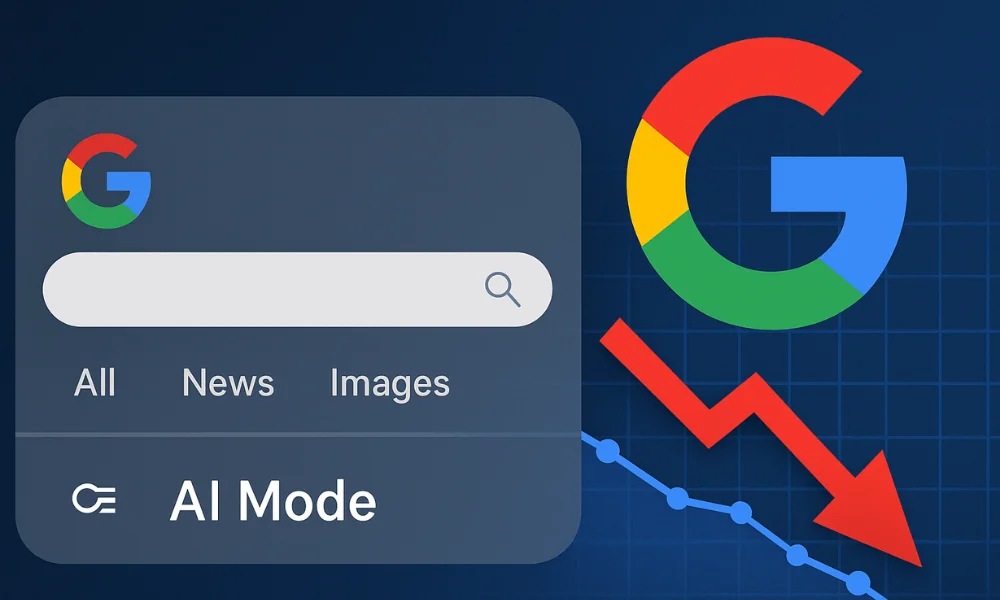In the past year, the media landscape has been shaken by the quiet but powerful rise of Google’s AI Mode Overviews. While users enjoy quick answers, major news sites are reporting a dramatic decline in web traffic, raising big concerns over the future of digital journalism.
Since Google’s AI Overviews began rolling out last May, many of the top news websites in the U.S. have reported sharp drops in traffic—some by as much as 40%—according to recent data from SimilarWeb. Despite a year packed with major political and global events, nearly 75% of the top 50 news domains have experienced a significant decline in visits.
At the center of the controversy: Google’s new AI-powered search summaries, designed to answer queries directly without requiring users to click through to publisher websites.
Key Takeaways:
- 37 out of 50 major news websites saw traffic drops since AI Overviews launched
- Forbes and HuffPost lost the most—each saw a 40% decline
- CNN, Fox News, Daily Mail, NY Post also reported steep traffic dips
- Publishers warn this threatens funding for high-quality journalism
- Click-through rates on AI Overview search results plunged by over 60% in one year
- Google claims AI enhances search and denies it’s the reason for traffic drops
Google’s AI Overviews: Changing How We Search—and Who Gets Clicks
Google’s AI Overviews are powered by its Gemini AI model. These summaries appear at the top of search results and offer a quick answer to a user’s question—sometimes detailed enough that users no longer need to click on any link.
While convenient for users, this change has had a chilling effect on news publishers who rely heavily on search-driven traffic.
According to SimilarWeb data, top sites hit hardest included:
- Forbes and HuffPost: down 40%
- DailyMail.com: down 32%
- CNN.com: down 28%
- FoxNews.com: down 24%
- NYPost.com and WSJ.com: down 27% and 17%, respectively
The News/Media Alliance, which represents over 2,200 news organizations, says the numbers paint a troubling picture. “This is certain to negatively impact our ability to invest in quality journalism,” said Danielle Coffey, CEO of the group.

Clicks Are Falling—Fast
The ripple effect goes beyond page views. According to several studies, click-through rates (CTR) for top organic search results on queries that trigger AI Overviews have plummeted. From 7.3% in March 2024, average CTR dropped to 2.6% by March 2025—a steep fall that’s making headlines across media circles.
This means even if a news outlet ranks #1 in search, it’s getting far fewer clicks than before—because Google’s AI already answered the question.
Google Responds: It’s Not All AI’s Fault
In response to mounting concerns, a Google spokesperson defended the company’s AI efforts, emphasizing its role in supporting web traffic.
“More than any other company, Google prioritizes sending traffic to the web,” the spokesperson told The Post, adding that “billions of clicks” are still delivered to websites daily.
They also pointed out limitations in SimilarWeb’s data, which does not track app activity, and said traffic changes can result from other factors—like seasonal trends, shifting user behavior, and ongoing SEO algorithm updates.
Not Everyone’s Losing
Interestingly, while some major players are struggling, a few publications are thriving in the new AI-dominated ecosystem.
According to SimilarWeb, Men’s Journal saw an astounding 415% spike in traffic, followed by CoolDown.com (+96%) and IndiaTimes.com (+77%). These gains suggest that niche content or alternative formats may be benefiting from the changing landscape.
Will Journalism Adapt or Shrink?
The rise of AI-powered search is clearly reshaping how people consume news—and how publishers get discovered. And while Google insists it’s creating new opportunities, many in the news industry are unconvinced.
Adding to the confusion, AI Overviews have occasionally appeared on topics Google previously promised to exclude—like sensitive breaking news. For example, a box summarizing the query “Anne Burrell death” appeared shortly after news of the incident broke, despite Google saying AI would avoid “hard news” topics.
Now, Google says AI Overviews will appear only when the system has high confidence and believes they “add value.”
Still, the concern remains: If AI gives users the answer up front, what incentive do they have to click on a journalist’s original work?
Conclusion
This evolving situation signals more than a tech shift—it’s a seismic change in the news economy. Publishers, tech leaders, and readers alike must ask: What does the future of journalism look like when AI mediates the entire information flow?
As traffic continues to fluctuate, one thing is clear—newsrooms will need to adapt fast or risk being left behind.
